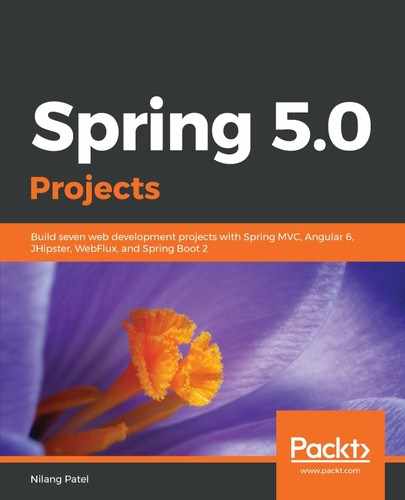JHipster is, in brief, a code generating tool, built on top of large collections of development, build, test, and deployment frameworks and platforms. It is a modern web application development platform, used to build all layers of a comprehensive Java-based web application, from the frontend to the database. JHipster supports various frameworks under the hood, giving the user options to choose from when starting application development.
JHipster is a free and open source platform aimed at greatly simplifying the process of generating, developing, and deploying monolithic and microservices-based applications on Spring Framework and Angular or React technologies. Before building an application in JHipster, a user will be asked various questions, in order to generate a production-ready application based on the options chosen by the user. JHipster provides the application with support for the following tools and frameworks, out of the box:
- Build tool: Maven, Gradle
- Development platform: Spring Framework
- Security framework: Spring Security
- Templating: Thymeleaf
- Microservices: Netflix OSS
- RDBMS: H2, MySQL, Oracle, PostgreSQL, MS SQL, MariaDB
- Data streaming: Kafka
- DB tracker: Liquibase
- NoSQL: MonboDB, Cassandra, Couchbase, Hazelcast
- Cache implementation: Infinispan, Ehcache
- Search engine: Elasticsearch and Elasticsearch, Logstash, and Kibana stack (ELK)
- Monitoring: Prometheus
- ORM: Hibernate
- Testing framework: Cucumber, Browsersync, Jest, Protractor test
- Load testing: Gatling
- UI: Bootstrap, HTML5, CSS3, SaaS, Redux
- JavaScript framework: Angular, Typescript, React, Webpack
- Deployment: Docker, Kubernetes, Boxfuse, Rancher
- Cloud support: Heroku, Cloud Foundry, AWS, OpenShift
- CI/CD: Jenkins, Travis CI, GitLab CI, CircleCI
The code generated by JHipster is as per industry standards, best practices, and quality compliance. Along with autogenerating application code, JHipster also supports automated testing and the continuous integration and delivery of the application in a more streamlined way. This can bring great benefits to an organization, as follows:
- Creating an application with various platforms and frameworks in a uniform and controlled way.
- Most of the boilerplate code is generated automatically, so a developer can focus on the implementation of business requirements. This will increase developer productivity and greatly improve the overall project delivery timeline.
- Easy integration of changes throughout the application, from the frontend to the database table.
- Improved code quality of the application, overall.
- Different projects in the organization can share common artifacts with ease. Consequently, the overall productivity of the project teams will be improved.
